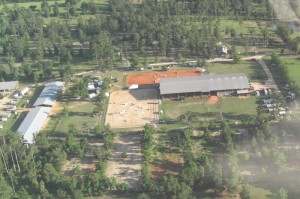Written by Barbara Newtown
Original Publish Date August 2013
Sharon Londono, new manager of Lagniappe Equestrian Center, can milk a cow, judge a Paso Fino, ride a motorcycle, shoot an elk, drive Santa Claus around town behind a team of Belgians, and figure out just the right mating to create an Olympic-level dressage horse. Above all, she is horse-crazy, and wants to help Lagniappe become the perfect place for horses and the people who enjoy them.
Lagniappe Equestrian Center, in Folsom, LA, boasts 200 acres of groomed trails, an indoor arena and two outdoor arenas, a 50-acre cross-country course, a barn and pastures for boarders, and show barns with room for 168 horses. Two trainers work at Lagniappe: Lauren Moore, whose specialties are lower-level dressage and hunter equitation, and Kathleen Aertker, a hunter/jumper coach and trainer.
Sharon and Lagniappe’s owners, Dr. Hildreth McCarthy and Jon Massey, share the vision for the center’s future: The facility has been a hidden treasure, and they want the equestrian community to know how welcoming and adaptable the place and its people are. On the schedule already are a schooling horse trial, clinics on shoeing and sacking out and dressage, dog agility shows, and several hunter/jumper shows. Cabins, hookups, and a clubhouse are available for rent. Riders who aren’t interested in competing might enjoy just spending a weekend camping and exploring the trails. For more information on Lagniappe Equestrian Center, call Sharon at (985) 796-9134.
Sharon’s winding road to her post at Lagniappe started in Wisconsin. Her family lived in Oconomowoc, but she loved visiting her grandfather’s dairy farm farther north in Hartford. The only problem with the dairy operation was that her grandfather couldn’t stand horses. “He belonged to the generation that hung up the harness when they bought the tractor,” she says. He called horses “hayburners,” because the hay was more valuable going to the cows. “We’re of German descent, as thrifty as they come. When horses were no longer a necessity, they became a luxury that a dairy farm shouldn’t have.” Her grandparents combined Christian virtue with hard work. “They lived off the land and butchered their food.” They respected animals, but believed that animals were put on earth to support mankind. Even though Sharon preferred equines to bovines, she still absorbed rural Wisconsin values: hard work, thrift, and practicality.
Sharon would occasionally jump on her aunt’s Arabian horses, but her formal riding did not start until she joined Girl Scouts. “You can only earn the Horsemanship badge once,” says Sharon, “but I kept doing it over and over, because I wanted opportunities to play with horses.” In those days the Horsemanship badge was strictly English, on the flat and over fences. Sharon did earn a few other badges, though; she became a First Class Scout, the highest level.
“In high school I’d ride my bike five miles to clean ten stalls and earn a lesson.” The barn owners caught Sharon riding around on their half Belgian mare without permission. They were so impressed with what Sharon had accomplished with Molly that they said, Keep riding her; what you’re doing is fine.
Sharon and her best friend competed in gymkhana games, doing pole bending, barrels, and walk/trot classes. By the time they went to college, Sharon was helping her friend with a side business of taking folks through the woods in a wagon pulled by a team, and serving the customers hotdogs, hot chocolate, and marshmallows. At Christmastime the girls would put Santa Claus in a cart behind a pair of Belgians and parade him around the Oconomowoc town square.
Sharon paid most of her way through Lakeshore College in Cleveland, WI, by getting up at 4:30 am to work at a dairy farm. She either did the morning milking shift or bucket-fed the calves. “The calves had to learn to eat milk replacer out of a bucket pretty fast,” she says. “You let them suck on your fingers and then pull your fingers away, and they start slurping.”
As she studied for her Equine Science degree, she participated in the entire riding program at Lakeshore. “I did all four seats: hunt seat, stock seat, saddle seat, and dressage.” At that time Lakeshore was not part of an intercollegiate riding program, but the students did have intramural teams. Sharon says that she was a jack-of-all-trades back then; the breed or the discipline didn’t matter. All she wanted was to get near a horse.
At the end of Sharon’s junior year she came to the attention of the head of the Equine Science program when she laughed a little too loudly at another student’s prank (something about hiding an equine condom in a professor’s notebook); the director thought she must be in on it. (She was innocent.) As a punishment she was sent to the summer job interview nobody else wanted: helping out at a Paso Fino farm in Elkhart Lake, WI. At that time, Paso Finos were rare in the U. S. and their gait, a rapid, up-and-down four-beat, was misunderstood. Sharon hopped on her motorcycle, drove to Elkhart Lake, and met the farm’s old German trainer, who hired her as a traveling show groom. Within three months she was training and showing the Pasos. Shows for Paso Finos were rare; as a result, Sharon was on the road three or four weeks at a time. During her senior year, she had planned to take the winter off from her work with the Pasos in order to study hard for honors at graduation. But at Christmastime the married couple who owned the farm died within weeks of each other—the wife from cancer, and the husband from asthma and emphysema. From spring until late summer Sharon helped the family sell off all the horses, because no one was left who had the interest or the knowledge to keep the farm going. By August, Sharon had dissolved the herd and had no job prospects.
Her luck changed with a call from the Lakeshore College placement office. There was a Paso Fino job in Texas. “I packed up my truck for a three-month stint and I haven’t been home since!”
The Paso Fino operation in Texas included breeding, training, and showing. Sharon found herself becoming a Paso Fino expert, and eventually she qualified as a large “R” — USEF judge for Paso Finos. Her judging has taken her to Canada, Colombia, Puerto Rico, Germany, and all over the U. S. Sharon has also continued her Equine Science education. She has received certificates from Colorado State in Equine Reproduction, Advanced Reproduction Techniques and Embryo Transfer, as well as a certificate from Texas A & M in Equine Nutrition.
The Paso Fino, says Sharon, has a long history; the breed developed from the Spanish Jennet, brought over to the New World by the conquistadors. The Spaniards preferred the ambling gait of the Jennet for their long rides. The Paso Fino developed over the next 400 years primarily in Colombia and Puerto Rico. In the 1960s some U. S. servicemen stationed in Puerto Rico fell in love with the Paso and brought their favorite mounts home. Horses were imported from Colombia as well, the two strains of the breed were combined, and in 1972 the Paso Fino Horse Association was formed.
Sharon points out that the Paso Fino gait is not man made, but is man enhanced. The gait has four evenly spaced beats, in the same sequence as the walk. The “classic paso” is very fast and has very little forward movement; this gait, done correctly, is rare. Perhaps one in a hundred Paso Finos can do it. The “performance Paso” horse, like a Saddlebred, is very animated, and shows both short steps and long steps. The “pleasure” division Pasos are smooth and quiet and suitable for amateurs. The “specialty” classes include conformation, costume, versatility (a jump is required), trail, and Western pleasure (lope is required). Sharon says, “Pasos sometimes get a bad rap because their feet are going up and down so fast. The horse looks hyper, ready to explode. But they’re calm and easy to handle; all the energy is going out their legs!” In conformation, a Paso Fino has many of the qualities you look for in a dressage warmblood: good hock movement, a beautiful head and an arched neck that comes out high from the withers. Of course, the horse has a four-beat gait rather than a two-beat trot! “The Paso is the perfect horse for someone who doesn’t want the concussion of the trot. It’s the perfect horse for someone who doesn’t want to give up riding, but is older, or sore, or disabled, or overweight,” says Sharon. As the population ages, she believes that interest in gaited horses will only grow stronger. “If you can sit in a chair, you can ride a Paso Fino.”
Sometimes people are confused about the difference between a Paso Fino and a Peruvian Paso. Paso Finos are supposed to track straight. Peruvian Pasos, on the other hand, exhibit “termino” movement, which looks like exuberant front-leg winging, and is considered a beautiful and desirable trait. Peruvians are larger and stouter than Paso Finos, which average 14.2 hands.
When Sharon was showing for the Texas Paso Fino ranch, she met a trainer from Colombia who was working for a doctor who had a Paso farm in Tennessee. Manny Londono saw Sharon working a horse and, says Sharon, “I guess I caught his fancy.” He followed her back to Texas and found a job there. Sharon’s bosses got a divorce and she returned to Wisconsin. Manny got his own boss to offer her a job and lure her back to Texas. “After that, it was romance…Here we are, 27 years later!”
A Paso Fino breeder in Louisiana heard about Manny and Sharon and hired them away from Texas. “We fell in love with Louisiana and bought land,” says Sharon. “The climate is milder and you can do horses all year long. The people are more down-to-earth, more appreciative. Here, if you’re different, you’re embraced!” When Sharon first arrived in Texas, she had Wisconsin plates on her truck, and she was run off the road once. “What the heck?!” she yelled…and the Texans yelled back, “Yankee go home!” In contrast, Louisianans are pleased to meet her and are delighted with her funny accent.
When Sharon and Manny first came to Louisiana, Sharon also worked for a veterinarian. He recommended that she apply for a job at Oak Hill Ranch in Folsom. Oak Hill, at that time, had llamas, Polish Arabians, and a couple of warmbloods. In 1992 Sharon started work at Oak Hill as a body clipper, getting Arabians ready for auction. Owner Richard Freeman became interested in breeding Danish Warmbloods. His breeding manager was only interested in Arabians, and Mr. Freeman asked Sharon to be the horse farm manager.
“Oak Hill was a dream job for me,” says Sharon. “I had awesome employees. I loved the facility. And the animals were a Godsend. I was truly blessed to see some of the best horse offspring on this earth. And I got to see them sold to appreciative owners.”
Sharon was able to travel to Denmark to meet the judges who were setting the breed standards for the Danish Warmbloods. The Danes mentored her and were generous with their knowledge of temperament and lineage and movement. Over the years Mr. Freeman created the foremost facility for bringing the best of Danish bloodlines to the U. S., and Sharon received a world-class education in dressage breeding.
“Be strong with your dam lines,” she says. “A good mare is harder to find than a good stallion. Be careful when combining defects: the strong points will always be there, but the defects can increase in effect. Sell off older horses, look for replacement fillies. Most important, be truthful and honest, and clients will stay with you.”
Sharon is honored to have known Rambo, the superb Danish stallion that Mr. Freeman purchased. With Rambo, she says, “the Danes built an actual ‘sport horse’—a horse that can do both dressage and jumping.” She speaks highly of such Oak Hill stallions as Don Caruso and Landtinus, horses that are so talented that other warmblood registries have welcomed them.
Heather Blitz, first alternate for the U. S. Dressage team at the 2012 London Olympics, worked with Sharon at Oak Hill for seven years as head trainer. “My passion is breeding. Through Heather I would get a sense of a horse’s temperament and rideability. We were partners in deciding which breedings would be best.” When Paragon, Heather’s future Olympic horse, was born, Sharon said, “Heather, you need to look at this horse!” Heather ended up buying him from Oak Hill for her own use. Sharon loved watching Heather and Paragon “perform magic—the lateral movements, the collected movements like pirouettes.” The quality of the performance correlated to the breeding.
Heather left Oak Hill after Hurricane Katrina and moved to Florida. “She has maintained her ties with Oak Hill Ranch, either by riding stock that we have bred or by giving clinics and lessons. But she needed to go find her wings and pursue her dream. She had to fly…but it was bittersweet. She has my utmost respect and admiration. She had a goal, and she works her tail off.”
Changes came to Oak Hill. Mr. Freeman and his wife took over the management of the operation, and Sharon was phased out in 2012. Dr. McCarthy of Lagniappe Equestrian Center saw Sharon hanging out at the local tack shop in the middle of the day and asked her why she wasn’t at work. When Dr. McCarthy realized that Sharon was available, she hired her right away, because her barn manager had just resigned so that she could take care of family matters. Now Sharon finds herself in the next phase of her professional life. “It’s a different perspective,” she says. “I’m dealing with boarders and a variety of equestrian activities. We’re fixing the place up and making it available to members of the horse community.” Sharon enjoys working with Dr. McCarthy. “She still foxhunts and drives her carriage horses.” Sharon’s expertise in breeding is not needed at Lagniappe, but she is helping the breeding program at Hillcat Farm in Folsom, where they are creating the hunters and conformation hunters of tomorrow.
Sharon and Manny live at Rancho Poker, Manny’s Paso Fino operation. “I really enjoy managing for other people, but my husband has always dreamed of being his own boss.” They have five children. Sharon is stepmother to three; the oldest is 39, and is a professional soccer player. Her second stepson would have been 31, but he was killed in a car accident three years ago. Her third stepson, 26, is a shift manager at an auto parts store. Her son Jacob, 24, a member of a special ops Navy helicopter unit, just got back from his second tour in the Middle East. “Annette is the only girl, my baby; she’s 17, a coming senior this year. She’s doing great. She’s an honor student, plays trumpet in the band, and already has colleges looking at her as a goalie.”
Sharon is not homesick for Wisconsin or Texas, but she loves Colorado, where she earned her equine specialty certificates. “I love the peace of Colorado, the majestic openness.” She hunts elk and whitetail deer in the Telluride area, in the southwest corner of the state. Her hunting values were formed when she was growing up in Wisconsin. “I heard story after story about how NOT to be a hunter. How a grown man can become a lunatic. If we shot a squirrel, we ate it. If we shot a bird, even a pigeon, we had to eat it. You learn real quick what to shoot and what not to shoot!”
Her favorite rifle? “I have my ‘engagement gift.’ One of the guys I dated in college gave me a rifle, and I guess it was supposed to be a ring, but I didn’t get the hint. A .270 Winchester. Bolt action, one shot at a time. When you’re good, you can reload in a couple of seconds. I think semi-automatics—where you just leave your finger on the trigger—are for someone who doesn’t practice. I have enough acreage now that I can practice at home.” Her daughter Annette hunts, too. Jacob, the Navy helicopter pilot, didn’t like hunting, but he ended up earning a sharpshooter award. “I said, ‘Now look where you are, with a piece of sharpshooter candy on your breast!’”
Look where Sharon is now—she has made a life filled with horses and family. The horse-crazy Wisconsin girl, who couldn’t get enough rides on the ponies at the carnival, who couldn’t earn the Horsemanship badge often enough, who wanted to know the science behind the sport, who tasted life at the top of the gaited and the warmblood worlds, is now managing a facility dedicated to helping horse-crazy people enjoy their equine companions.





